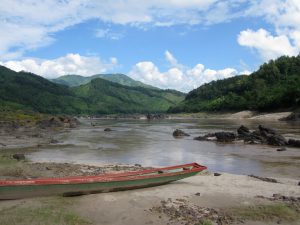The Thai government has warned that it might refuse to buy electricity from a planned hydropower dam in Laos due to the negative environmental impacts, potentially throwing the controversial project into doubt.
In comments to the Bangkok Post newspaper, Somkiat Prajamwong, secretary-general to the Office of National Water Resources, said that the Prime Minister Prayut Chan-o-cha’s cabinet had grave concerns about the impact of the Sanakham dam project on the ecological system of the Mekong River, as well as the livelihoods of those living along its banks.
He said Thai authorities were also concerned that the location of the dam was too close to the river, which demarcates an 800-kilometer stretch of its border with Laos.
“The country’s territory is our paramount concern,” Somkiat said after a seminar on the Mekong River in Bangkok, adding that the Ministry of Energy felt the country had an oversupply of power and didn’t need to buy any more from Laos. “The Thai government has the authority to decide whether or not the project greatly damages the environment,” he said.
The Sanakham dam, which is located about two kilometers from the Thai border on the Mekong, is one of seven planned dam projects on the mainstream of the Mekong River in Laos, part of Vientiane’s plan of transforming itself into the “Battery of Southeast Asia.” The 684-megawatt project will be constructed by a subsidiary of Datang International Power generation, a Chinese state-owned power company, and is expected to be completed by 2028.
The four-nation Mekong River Commission (MRC) officially began its six-month prior consultation phase for the Sanakham project on 30 July, when other governments are able to raise concerns about dam projects. Since then, activists and dam opponents have pointed out that Thailand has a glut of electricity, and called on Bangkok to withdraw its support for the project. In June of this year, the Bangkok Post wrote in an editorial, “The proposed Sanakham dam is expensive, unnecessary and risky – and should be cancelled.”
Somkiat’s comments came a day ahead of the MRC’s 27th Council meeting, at which Deputy Prime Minister Prawit Wongsuwon stated that the benefits of the mighty river’s resources should be shared equally among the five downstream nations. “Any discussion must be done based on ‘One Mekong One Spirit’ to make balance of people, economic growth and environment. And we won’t leave anyone behind,” Prawit said.
How much to take from this remains uncertain, but recent comments indicate that governments are slowly starting to catch on to what ecologists and environmentalists have been saying for years: that hydropower dams and other river alterations pose an existential threat to one of Asia’s great rivers.
The Mekong arises in China and then flows through five ASEAN member states, where it is central to the livelihoods of more than 60 million people. Over the past two years, the river has been hit by a severe drought that has left stretches of the river along the border with Laos and Thailand dried up and exposed to the sun. This followed on the heels of another record dry-spell in 2016.
One strong contributor to the drought, many environmental researchers believe, is the string of dams on the upstream of the Mekong River inside China, where it is known as the Lancang. This year, a U.S.-government funded study was published claiming a yawning mismatch between the recent volume of rainfall on the Chinese portion of the Mekong and the water levels downstream.
The Chinese government has disputed the report’s claims. Further challenges are posed by the glut of dam projects – both operational and planned – on the Mekong and its tributaries, mostly in Laos and Cambodia.
As the effect of drought and plummeting fish stocks hit home, the region’s governments have started to reconsider the benefit of developments on the river. In February, the Thai government scrapped a Chinese-led project to blast rapids on the Mekong due to the deleterious environmental and livelihood impacts. The following month, Cambodia postponed the construction of new hydropower dams on the Mekong until 2030. Both of these took place against increasingly vocal requests from Vietnam, Thailand, and Cambodia that the Lao government widen the impact assessments of its dam projects and propose additional measures to mitigate adverse impacts.
Despite the dawning of urgency into the region’s governments, many environmentalists believe that the current structures of river governance centered on the MRC are inadequate to the urgency of the task.
“The people of Laos, Cambodia, Myanmar, Thailand and Viet Nam who rely on the Lower Mekong are not looking to the MRC to conduct additional assessments,” Marc Goichot of the World Wildlife Fund wrote ahead of the MRC Council meeting. “They need urgent action to enhance the health of the river, which is the foundation of their societies and economies.”

































